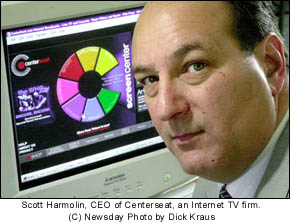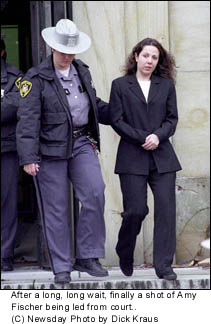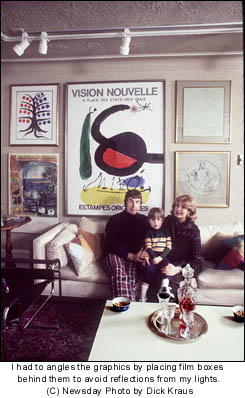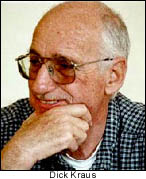PHOTOJOURNALISM ISN'T ALWAYS ABOUT NEWS
by Dick Kraus
Newsday
Staff Photographer
Whenever people at social events hear that
I am a newspaper photographer, their reaction is always, "Oh, how exciting
that must be!"
They tell me how lucky I am to be able
to travel around the world and cover all of the exciting events that occur
in our lifetime. I have to explain to them that I mostly cover community
news. That means that I rarely visit the White House or travel with the
President. I have yet to cover any of the wars that crop up around this
troubled globe. I don't often live out of a suitcase and transmit my photos
of breaking news events from a laptop computer plugged into a phone. For
the most part, I cover local events on Long Island. Things like meetings
of the Legislatures in the two counties that make up the greater geography
of Long Island. We spend a lot of time looking for weather floaters. Sometimes
I get to New York City. Sometimes I travel to other parts of the country
and the world. But, mostly I photograph felons who have been arrested as
they are being taken to arraignment court from some police precinct. I
cover a lot of court cases, but we aren't allowed in courts with cameras
these days, so my compatriots and I wait outside in the cold or the heat
for a chance to make a photo.  I
do an awful lot of photos for our Business Section. Which usually means
a head shot of some CEO or a shot of the CEO at a computer or phone or
desk or whatever. I shoot a lot of "High School Athlete of the Week" headshots.
Then there are the hundreds of "headshots" of buildings for our Real Estate
Section and photos of intersections where some citizen's group wants a
light or a stop sign. Our photo staff sings a little ditty when someone
asks, "What did you shoot, today?" The response is "Headshots and real
estate," sung to a lilting melody. I
do an awful lot of photos for our Business Section. Which usually means
a head shot of some CEO or a shot of the CEO at a computer or phone or
desk or whatever. I shoot a lot of "High School Athlete of the Week" headshots.
Then there are the hundreds of "headshots" of buildings for our Real Estate
Section and photos of intersections where some citizen's group wants a
light or a stop sign. Our photo staff sings a little ditty when someone
asks, "What did you shoot, today?" The response is "Headshots and real
estate," sung to a lilting melody.
And even when we are covering some big
story, whether local or away, so much of our time is spent waiting for
something to happen. Waiting. And waiting. It's what we do.  Waiting
for hours and hours. Waiting to get a shot of some crazed individual who
killed his entire family and threatens to kill anyone who comes near. So,
we wait for hours until the police negotiators talk him into giving up.
Waiting and waiting outside the courtroom for a jury verdict. Even on stories
that make national headlines. Can you imagine the man hours spent by tv,
radio and print journalists and camera people, waiting to get a shot of
Amy Fischer or Joey Buttafuouco when that case was in the courts.
The lobby of that courthouse was packed with cameras, electronics, reporters,
photographers, producers. There would be a flurry of activity in the morning
when the protagonists and their families and lawyers arrived. Then there
would be hour upon hour of waiting. Waiting. Crews would stretch out on
the hard stone benches. Others would sit on the marble floor and read and
reread every newspaper that was sold at the news stand. Waiting. And suddenly,
people would pour out of the courtroom and we would grab our cameras and
spend another hectic fifteen minutes shooting before everyone was gone.
Ten hours, perhaps, of coverage. And maybe a half hour of actual shooting.
Then we would do it all over again the next day. And the next. Waiting. Waiting
for hours and hours. Waiting to get a shot of some crazed individual who
killed his entire family and threatens to kill anyone who comes near. So,
we wait for hours until the police negotiators talk him into giving up.
Waiting and waiting outside the courtroom for a jury verdict. Even on stories
that make national headlines. Can you imagine the man hours spent by tv,
radio and print journalists and camera people, waiting to get a shot of
Amy Fischer or Joey Buttafuouco when that case was in the courts.
The lobby of that courthouse was packed with cameras, electronics, reporters,
photographers, producers. There would be a flurry of activity in the morning
when the protagonists and their families and lawyers arrived. Then there
would be hour upon hour of waiting. Waiting. Crews would stretch out on
the hard stone benches. Others would sit on the marble floor and read and
reread every newspaper that was sold at the news stand. Waiting. And suddenly,
people would pour out of the courtroom and we would grab our cameras and
spend another hectic fifteen minutes shooting before everyone was gone.
Ten hours, perhaps, of coverage. And maybe a half hour of actual shooting.
Then we would do it all over again the next day. And the next. Waiting.
Does this sound kind of dull? Certainly.
It usually quenches the enthusiasm that fueled the original statement from
my fellow party-goers when they told me how lucky I was to have such an
exciting job. I try to explain to them that news work is 95% boredom and
tedium, but that the other 5% more than compensates for the rest. I have
gotten to cover some wonderful and exciting assignments, locally and around
the world. But, by that time, the conversation has switched to crab grass
and the latest sale at Home Depot.
If that 95% to 5% ratio is real, why then
would I have continued in this profession for over 40 years? As I said,
the 5% of assignments are challenging, adrenaline pumping jobs. They usually
produce some memorable photos.
 But,
there's more to it than that. As the title of this journal states, photojournalism
isn't always about news. Take a look at your local paper or watch your
local tv station. There are features that have to be illustrated. At Newsday,
we have special sections for Science, Health, Home, Fashion, Food, Entertainment,
Real Estate, and Business. Some of these can be fun. Some are challenging. But,
there's more to it than that. As the title of this journal states, photojournalism
isn't always about news. Take a look at your local paper or watch your
local tv station. There are features that have to be illustrated. At Newsday,
we have special sections for Science, Health, Home, Fashion, Food, Entertainment,
Real Estate, and Business. Some of these can be fun. Some are challenging.
I enjoy shooting food in our studio, or
on location. I love the challenge of making food look appetizing and natural.
I love using lighting to create texture and gloss to enhance the look.
Fashion can be fun. Especially on location. And, of course, the models
are always nice to look at. I've had a great time photographing interviews
with some of the entertainment stars. Some of them are actually delightful
people. Others are....well, less delightful.
Making photographs for the home section
is really an exercise in trying to show the decor and trying to keep the
walls from keystoning. We have writers for that section who can't understand
why we can't show all four walls in the same photo. One gal was a real
pip. She was an older woman and very short. I always work on a tripod when
I shoot home interiors and she would always insist on looking through my
camera to ensure that I showed everything that she wanted. The problem
for her was that I am 6'3" and she was 4' nothing. She would rise on her
tiptoes and still be 2' short of being able to see and it would infuriate
her. Bill Senft, one of our photographers, always carried a 21mm accessory
viewfinder from an old Leica rangefinder camera that he no longer owned.
He would hand it to her and say, "Here, Doris. Now you can see what I am
getting." She adored Bill. Of course, he might have been using a 35mm lens,
but Doris was happy.
 I
once had to shoot a home that was decorated with framed graphics. There
were graphics on every wall. Each one in a glass covered frame. I brought
in my studio electronic flash units and set them up to get balanced, even
lighting. Then I had to check for reflections in those accursed glass covered
graphics. We didn't have the luxury of modeling lamps in the units that
would show if there were any reflections from the lights. Nor did I have
a Polaroid back. Or now, we have digital Nikon D-1's with LCD viewing screens
that allow us to check lighting and reflections. So, I had to fire my lamps
and squint my eyes to try to catch any reflections from the camera position.
If I found one, I would take a box of Kodak 35mm film and place it behind
one edge of the frame to angle it slightly. The film boxes were perfect
because they didn't make the angle change obvious in the photo, but they
did allow the light to bounce away from the camera. Nice trick. I don't
remember which photographer showed it to me, but I am eternally grateful
because knowledge like that always comes in handy and has saved my bacon
on more than one shoot. I
once had to shoot a home that was decorated with framed graphics. There
were graphics on every wall. Each one in a glass covered frame. I brought
in my studio electronic flash units and set them up to get balanced, even
lighting. Then I had to check for reflections in those accursed glass covered
graphics. We didn't have the luxury of modeling lamps in the units that
would show if there were any reflections from the lights. Nor did I have
a Polaroid back. Or now, we have digital Nikon D-1's with LCD viewing screens
that allow us to check lighting and reflections. So, I had to fire my lamps
and squint my eyes to try to catch any reflections from the camera position.
If I found one, I would take a box of Kodak 35mm film and place it behind
one edge of the frame to angle it slightly. The film boxes were perfect
because they didn't make the angle change obvious in the photo, but they
did allow the light to bounce away from the camera. Nice trick. I don't
remember which photographer showed it to me, but I am eternally grateful
because knowledge like that always comes in handy and has saved my bacon
on more than one shoot.
 OK.
So maybe these things may not sound as glamorous as traveling around the
world in Air Force One. But, for me, the thrill of overcoming the challenges
presented on some of these lesser assignments can be just as rewarding.
I've been doing it for forty plus years and, God willing, I'll keep doing
it for awhile longer. OK.
So maybe these things may not sound as glamorous as traveling around the
world in Air Force One. But, for me, the thrill of overcoming the challenges
presented on some of these lesser assignments can be just as rewarding.
I've been doing it for forty plus years and, God willing, I'll keep doing
it for awhile longer.
|


 I
do an awful lot of photos for our Business Section. Which usually means
a head shot of some CEO or a shot of the CEO at a computer or phone or
desk or whatever. I shoot a lot of "High School Athlete of the Week" headshots.
Then there are the hundreds of "headshots" of buildings for our Real Estate
Section and photos of intersections where some citizen's group wants a
light or a stop sign. Our photo staff sings a little ditty when someone
asks, "What did you shoot, today?" The response is "Headshots and real
estate," sung to a lilting melody.
I
do an awful lot of photos for our Business Section. Which usually means
a head shot of some CEO or a shot of the CEO at a computer or phone or
desk or whatever. I shoot a lot of "High School Athlete of the Week" headshots.
Then there are the hundreds of "headshots" of buildings for our Real Estate
Section and photos of intersections where some citizen's group wants a
light or a stop sign. Our photo staff sings a little ditty when someone
asks, "What did you shoot, today?" The response is "Headshots and real
estate," sung to a lilting melody.
 Waiting
for hours and hours. Waiting to get a shot of some crazed individual who
killed his entire family and threatens to kill anyone who comes near. So,
we wait for hours until the police negotiators talk him into giving up.
Waiting and waiting outside the courtroom for a jury verdict. Even on stories
that make national headlines. Can you imagine the man hours spent by tv,
radio and print journalists and camera people, waiting to get a shot of
Amy Fischer or Joey Buttafuouco when that case was in the courts.
The lobby of that courthouse was packed with cameras, electronics, reporters,
photographers, producers. There would be a flurry of activity in the morning
when the protagonists and their families and lawyers arrived. Then there
would be hour upon hour of waiting. Waiting. Crews would stretch out on
the hard stone benches. Others would sit on the marble floor and read and
reread every newspaper that was sold at the news stand. Waiting. And suddenly,
people would pour out of the courtroom and we would grab our cameras and
spend another hectic fifteen minutes shooting before everyone was gone.
Ten hours, perhaps, of coverage. And maybe a half hour of actual shooting.
Then we would do it all over again the next day. And the next. Waiting.
Waiting
for hours and hours. Waiting to get a shot of some crazed individual who
killed his entire family and threatens to kill anyone who comes near. So,
we wait for hours until the police negotiators talk him into giving up.
Waiting and waiting outside the courtroom for a jury verdict. Even on stories
that make national headlines. Can you imagine the man hours spent by tv,
radio and print journalists and camera people, waiting to get a shot of
Amy Fischer or Joey Buttafuouco when that case was in the courts.
The lobby of that courthouse was packed with cameras, electronics, reporters,
photographers, producers. There would be a flurry of activity in the morning
when the protagonists and their families and lawyers arrived. Then there
would be hour upon hour of waiting. Waiting. Crews would stretch out on
the hard stone benches. Others would sit on the marble floor and read and
reread every newspaper that was sold at the news stand. Waiting. And suddenly,
people would pour out of the courtroom and we would grab our cameras and
spend another hectic fifteen minutes shooting before everyone was gone.
Ten hours, perhaps, of coverage. And maybe a half hour of actual shooting.
Then we would do it all over again the next day. And the next. Waiting.
 But,
there's more to it than that. As the title of this journal states, photojournalism
isn't always about news. Take a look at your local paper or watch your
local tv station. There are features that have to be illustrated. At Newsday,
we have special sections for Science, Health, Home, Fashion, Food, Entertainment,
Real Estate, and Business. Some of these can be fun. Some are challenging.
But,
there's more to it than that. As the title of this journal states, photojournalism
isn't always about news. Take a look at your local paper or watch your
local tv station. There are features that have to be illustrated. At Newsday,
we have special sections for Science, Health, Home, Fashion, Food, Entertainment,
Real Estate, and Business. Some of these can be fun. Some are challenging.
 I
once had to shoot a home that was decorated with framed graphics. There
were graphics on every wall. Each one in a glass covered frame. I brought
in my studio electronic flash units and set them up to get balanced, even
lighting. Then I had to check for reflections in those accursed glass covered
graphics. We didn't have the luxury of modeling lamps in the units that
would show if there were any reflections from the lights. Nor did I have
a Polaroid back. Or now, we have digital Nikon D-1's with LCD viewing screens
that allow us to check lighting and reflections. So, I had to fire my lamps
and squint my eyes to try to catch any reflections from the camera position.
If I found one, I would take a box of Kodak 35mm film and place it behind
one edge of the frame to angle it slightly. The film boxes were perfect
because they didn't make the angle change obvious in the photo, but they
did allow the light to bounce away from the camera. Nice trick. I don't
remember which photographer showed it to me, but I am eternally grateful
because knowledge like that always comes in handy and has saved my bacon
on more than one shoot.
I
once had to shoot a home that was decorated with framed graphics. There
were graphics on every wall. Each one in a glass covered frame. I brought
in my studio electronic flash units and set them up to get balanced, even
lighting. Then I had to check for reflections in those accursed glass covered
graphics. We didn't have the luxury of modeling lamps in the units that
would show if there were any reflections from the lights. Nor did I have
a Polaroid back. Or now, we have digital Nikon D-1's with LCD viewing screens
that allow us to check lighting and reflections. So, I had to fire my lamps
and squint my eyes to try to catch any reflections from the camera position.
If I found one, I would take a box of Kodak 35mm film and place it behind
one edge of the frame to angle it slightly. The film boxes were perfect
because they didn't make the angle change obvious in the photo, but they
did allow the light to bounce away from the camera. Nice trick. I don't
remember which photographer showed it to me, but I am eternally grateful
because knowledge like that always comes in handy and has saved my bacon
on more than one shoot.
 OK.
So maybe these things may not sound as glamorous as traveling around the
world in Air Force One. But, for me, the thrill of overcoming the challenges
presented on some of these lesser assignments can be just as rewarding.
I've been doing it for forty plus years and, God willing, I'll keep doing
it for awhile longer.
OK.
So maybe these things may not sound as glamorous as traveling around the
world in Air Force One. But, for me, the thrill of overcoming the challenges
presented on some of these lesser assignments can be just as rewarding.
I've been doing it for forty plus years and, God willing, I'll keep doing
it for awhile longer.